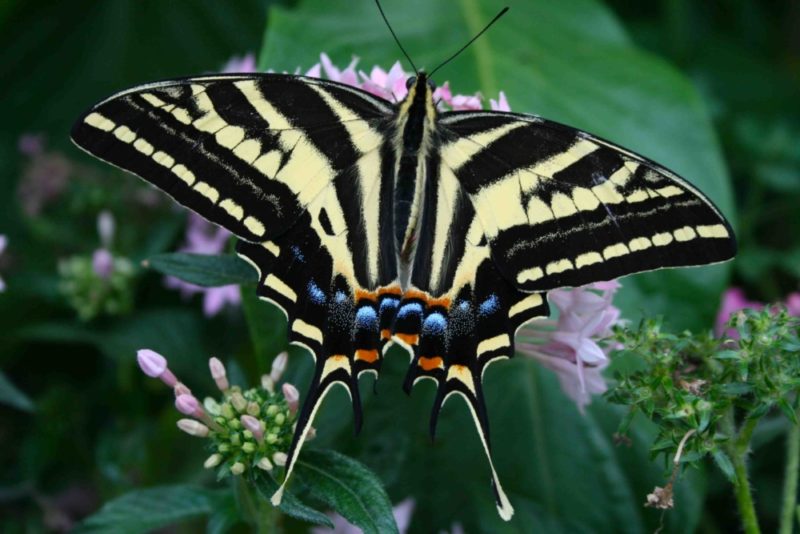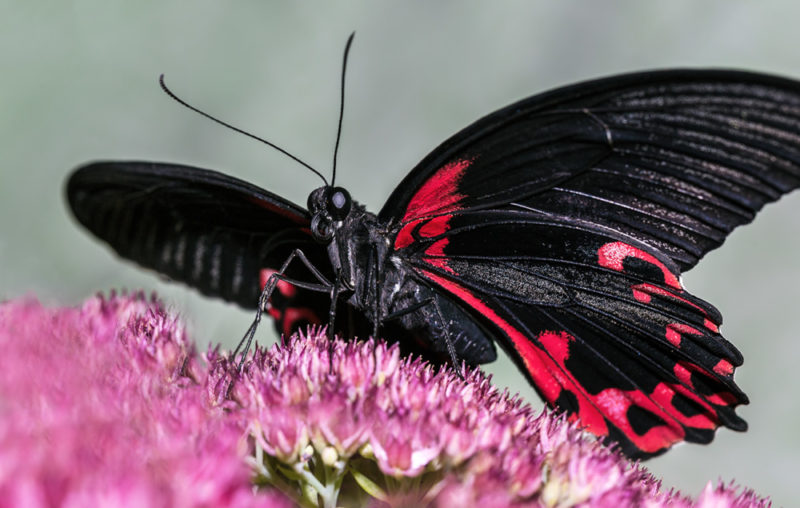Bright and beautiful insects live in our area, however, they cannot be called huge. Depending on the species, their wingspan can be up to 15 centimeters. But on the planet there are much larger moths that strike the mind with their size and shape. Let’s try to determine which is the largest butterfly in the world.
Material Content:
Description and name of the largest butterflies in the world
It is easy to confuse a butterfly in a calm state with a flower, and in flight - with a small bird. But most of all, large individuals are surprised, which even scare a little. Despite their impressive size, almost all of these creatures are absolutely harmless, with the exception of a few representatives.
Meet the ten largest butterflies:
- 10th place: Urania Madagascar is a moth whose wings are incredibly beautiful in color: from deep blue at the base to rainbow overflow at the ends;
- 9th place: Maca Sailboat is a day butterfly, which can be found in Russia;
- 8th place: Peacock-eye Pear - a real night queen;
- 7th place: Saturnia Madagascar (Madagascar Comet) - a moth with long elongated wings in the form of a tail, which was the reason for this name;
- 6th place: Birdwing Goliath - an expensive butterfly with golden wings;
- 5th place: Antimah Sailboat - the largest of the day butterflies, but very poisonous;
- 4th place: Peacock-eye Atlas - a butterfly whose caterpillars produce silk;
- 3rd place: Peacock-eye Hercules - a night butterfly opening the three leaders, the color of which resembles the eyes of a bird;
- 2nd place: Queen Alexandra's Birdwing (Ornithopter) - the second largest moth in the world in green and black;
- 1st place: Titania Agrippina (Scoop) - the leader of the rating, a vanishing insect with the largest wing area.
Despite the similar size, each of these creatures has its own unique color, habitat and lifestyle features.
Giant Butterfly Habitat
The habitat of large butterflies is quite wide. Many countries can boast that these giants live on their territory. But since beautiful creatures are very thermophilic, most of them are concentrated in tropical rainforests. Wide leaves create a greenhouse effect in the thickets, so insects feel comfortable.
Butterflies play an important role in the forest ecosystem.
They pollinate plants and are part of the food chain. But in some cases they can act as pests, as certain species of moths and their caterpillars feed on tree bark, fruits. In parallel, these insects sometimes become pathogens and carriers of infections and fungi.
This state of things is observed in places where the largest number of giant butterflies live.
They are found in such areas:
- America (South and Central);
- Brazil;
- about. Papua New Guinea;
- Australia;
- Southeast Asia;
- equatorial and tropical regions of Africa;
- about. Sulawesi;
- Moluccan skeleton;
- Philippines (about. Palawan);
- Indonesia;
- about. Madagascar;
- Russia (Tyndu, Sakhalin).
What is noteworthy, the size of insects directly depends on the climate: the warmer the air, the larger the butterfly can grow.
What does the largest insect look like?
In addition to huge butterflies in the world, there are other fairly large insects. For example, a lumberjack beetle, an elephant beetle, a giant mantis. They can exceed moths in weight and body length, but, taking into account the wingspan, giant butterflies remain leading.
The largest moth that has been seen by man is Tizania Agrippina. This creature is truly surprising in its size. Opened thirty centimeter wings of this insect can easily close the monitor screen. It is amazing, isn't it? And in calm form, this creature is very much like a bird. The edges of the wings are neat, zigzag.
The coloring of such a butterfly is also quite unusual. On her body many shades of gray, brown and soft milk colors are intertwined. Smooth lines as if imitate sea waves. With such “camouflage” the moth can easily disguise itself as a tree bark, mixed soils and stones. Body size can reach 9-10 centimeters. The color resembles a zebra - the same striped.
Lifestyle and Reproduction
Studying large butterflies is a complex and painstaking process. But nevertheless, some data on these insects are known. They are divided into night and day according to lifestyle. Of the daytime, the brightest representative is the Sailboat Antimach. In the daytime, he eats, pollinates plants and multiplies. By the way, females are always smaller than males. They can migrate over short distances due to changes in wind direction and other climatic conditions.
Of the nocturnal moths, the largest rightfully recognized Scoop Agrippina. Unlike its predecessor, it enters into activity in the dark. Females release an odorous secret, the smell of which comes from the fertilizer. An interesting fact is that males can smell this scent for several kilometers. After mating, the female lays eggs on the ground or plants. From them caterpillars appear. During the day, they hide in shelters, and go out at night to eat. In the third stage, the caterpillar turns into a closed pupa. At the last stage, her wings appear, and the individual becomes a full butterfly.
Power Features
The largest day butterfly, like most of its relatives, is a herbivore.
Titania Agrippina eats cassia leaves.This is a shrub that grows in Central and South America, as well as in Mexico. This plant can reach 1 meter in height, so Scoops have no problems with a lack of food. In parallel with this, such a moth and its larvae would like to enjoy various legumes.
Rare species of butterflies of impressive size are characterized by optional predation. Worms and scale insects may be included in their diet. And also individual individuals prefer flowers and fruits, which are harmful to farmers and horticultural farms. Those representatives of insects that eat whole grains in warehouses come into conflict with humans.
The size of the wings of the largest butterfly in the world
The most interesting thing is to imagine how big these giant butterflies are.
So, the wingspan of these insects is as follows:
- Titania Agrippina (Scoop) - 31 centimeters.
- Queen Alexandra (Ornithopter) bird wing - 28 centimeters.
- Peacock-eye Hercules - 27 centimeters.
- Peacock-eye Atlas - 26 centimeters.
- Sailboat Antimach - 23 centimeters.
- Birdcage Goliath - 21 centimeters.
- Saturnia Madagascar (Madagascar Comet) - 18 centimeters.
- Peacock-eye Pear - 15 centimeters.
- Sailboat Mac - 13 centimeters.
- Urania Madagascar - 10 centimeters.
Of course, these indicators are approximate. It is possible that in the dense thickets of forests where no human foot has stepped, larger handsome men also live.
Giant butterflies are a miracle of nature, which requires careful storage and care. Caring for these insects will allow our descendants to rejoice for many centuries looking at them.

















